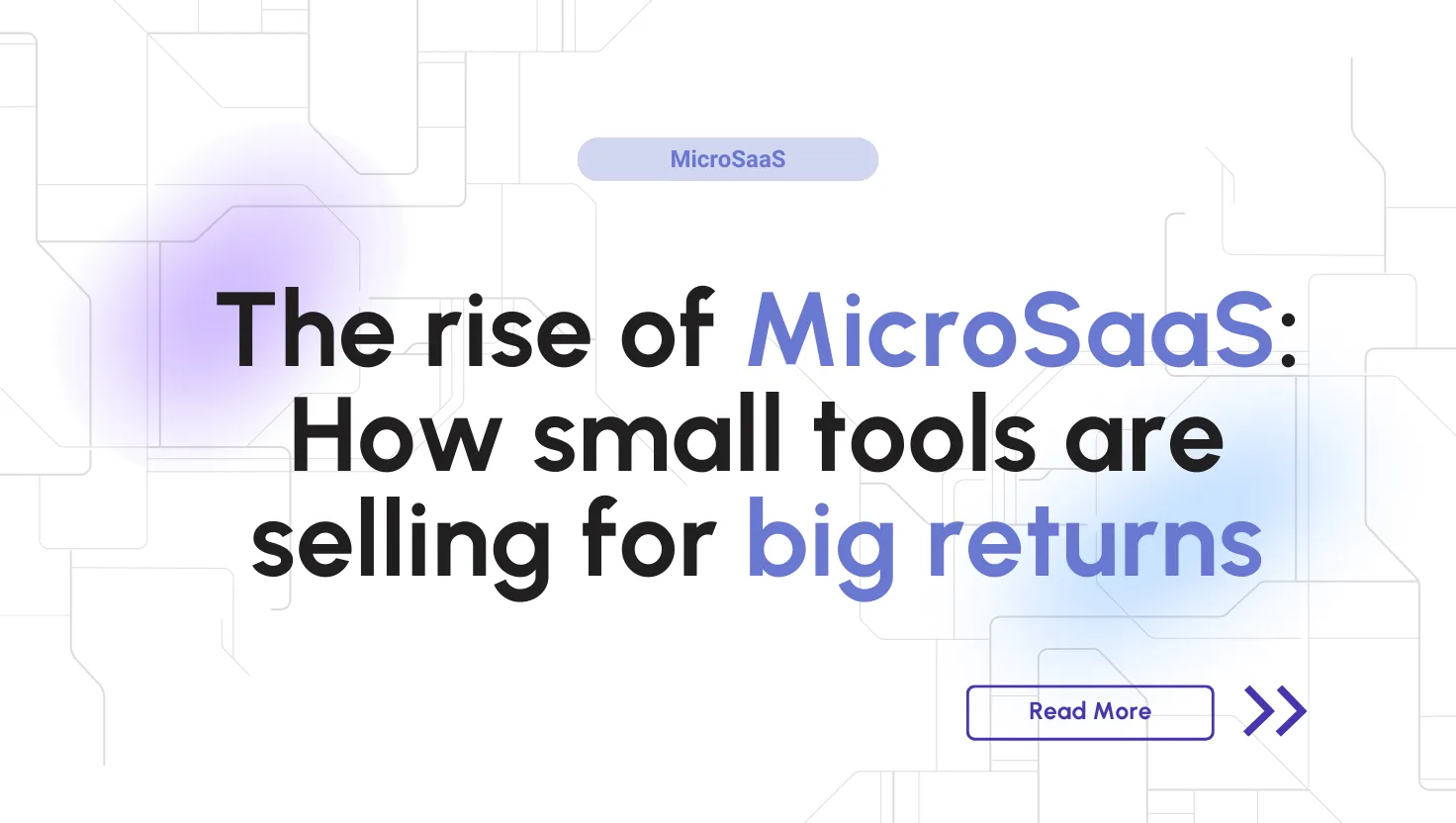Table of Contents
Being small in digital entrepreneurship can be an edge. Solo founders and tiny teams are turning that agility into MicroSaaS ventures – sharp, niche tools built to solve one problem really well.
While these apps may look modest compared to large-scale SaaS platforms, they are commanding serious attention in the acquisition market. On platforms like Flippa, it’s not unusual to see MicroSaaS companies with just $10K in monthly recurring revenue (MRR) sell for six- or even seven-figure sums.
The appeal is clear: lean cost structures, predictable recurring revenue, and highly targeted audiences make MicroSaaS one of the hottest segments in digital M&A today.
What exactly is MicroSaaS?
Unlike traditional SaaS companies that may target broad enterprise use cases, MicroSaaS is just a small, focused software-as-a-service business.
It usually does one thing really well, serves a niche audience, and is often run by a solo founder or a very small team. Think of it as a lightweight SaaS with low overhead, steady recurring revenue, and the potential to be profitable without needing venture capital.
Key characteristics include:- Small teams (often solo founders)
- Niche focus – e.g., Chrome extensions, WordPress plugins, Shopify apps, analytics for specific industries
- Recurring subscription revenue
- Low overhead and high margins
Think of tools like a content optimization Chrome extension or a Shopify integration that automates a single task. While simple in scope, these tools can be indispensable for their users and highly valuable to buyers.
Why MicroSaaS is gaining traction
Several macro and market factors explain the surge in MicroSaaS:
-
Low barriers to entry
No need for venture capital. Many MicroSaaS apps are built and launched by a single developer. For example, Tanya van Gastel, a first-time founder, along with her two co-founders, bootstrapped an AI headshot generator from scratch for just $700. The app eventually sold on Flippa for a six-figure sum.
Her story illustrates exactly how even small, lean, founder-led SaaS businesses can quickly attract buyers when they solve a timely need.
- Mainstream adoption of subscriptions: Consumers and businesses are increasingly comfortable paying for niche software on a monthly or annual basis.
- Remote work & digital entrepreneurship: The rise of independent founders has fueled a wave of niche problem-solving tools.
- Appeal to buyers: For investors and operators, MicroSaaS businesses are “plug-and-play” – easy to integrate, and capable of delivering ROI quickly.
The transaction data on Flippa confirms the trend. In 2024 alone, the marketplace facilitated 795 SaaS sales, with MicroSaaS making up a significant portion of activity.
The economics of MicroSaaS Exits
Unlike venture-backed SaaS, where valuations can be inflated by growth projections, MicroSaaS businesses tend to trade on real performance metrics like profit multiples and predictable cash flow.
Flippa’s latest SaaS Multiples Report shows: shows:
- Typical valuations: Owner-operated SaaS businesses under $1M ARR usually sell for 2x – 4x profit multiples, depending on churn, retention, and defensibility.
- Premium multiples: Businesses with $10K+ MRR and strong retention can command 3x – 5x annual revenue.
- Buyer demand: Private equity funds, roll-up operators, and even individual entrepreneurs are actively seeking MicroSaaS for their scalability and low-risk profiles.
For example, a sports data analytics SaaS listed on the Flippa platform with $18K in MRR sold for $720K at a 2.8x profit multiple, reflecting the appetite for lean, recurring revenue models.
Key drivers of high returns
What makes MicroSaaS businesses so attractive to acquirers?
- Recurring Revenue Predictability: Subscriptions provide stable, forward-looking cash flow.
- Strong Retention & Low Churn: Niche users are often highly loyal. Flippa’s buyer data shows deals with churn below 6% are most in demand.
- High Margins: SaaS businesses typically report 70 – 85% gross margins. MicroSaaS, with lower overhead, can reach the higher end of that range.
- Growth Potential: Acquirers often see opportunities in scaling what founders haven’t invested in: marketing, partnerships, or integrations.
Risks and limitations of MicroSaaS
Of course, not all MicroSaaS businesses achieve big exits.
Key risks include:- Founder dependency: Knowledge transfer is challenging if one person builds and runs everything. Buyers often discount valuations if the business is too dependent on a single individual or platform.
- Platform reliance: Apps built entirely on Chrome, Shopify, or WordPress risk sudden policy changes.
- Market saturation: Some niches (e.g., SEO tools, productivity apps) are crowded.
- Growth ceiling: Hyper-niche products may struggle to scale beyond a limited user base.
How founders can position for a profitable exit
For founders, preparing a MicroSaaS for sale means more than just building a good product. Key strategies include:
- Clean financials: Ensure recurring revenue is clearly visible in reporting.
- SOPs & documentation: Reduce buyer concerns about single-founder risk.
- Customer support & systems: Show operational maturity.
- Defensible niche positioning: Cultivate a loyal customer base in a niche that’s hard to copy.
- Timing: The best exits often occur while revenue is growing steadily, not after plateauing.
Flippa’s valuation calculators and broker insights help founders benchmark their business and identify areas to improve before going to market. If you’re curious what your SaaS business could sell for, get a free valuation and find out.
The future of MicroSaaS in M&A
Looking ahead, several trends will shape MicroSaaS exits:
- More acquisitions by aggregators: Similar to e-commerce roll-ups, SaaS aggregators are now targeting MicroSaaS portfolios.
- AI & no-code lowering barriers: Expect more founders building small but valuable SaaS tools faster and cheaper.
- Mainstream asset class: MicroSaaS could soon be as common a buy/sell asset as content sites or e-commerce stores.
SaaS remains resilient with median private valuations around 3.3x revenue, and AI adoption (now at 70% among SaaS companies) is fueling new opportunities.
Conclusion
Flippa’s data shows that MicroSaaS is no longer just a niche; it has become a thriving market where small, well-run tools create real value for both buyers and founders. For founders, MicroSaaS offers a path to independence and a proven build-and-sell strategy. For investors, these businesses provide efficient, cash-flowing assets with significant upside potential.




